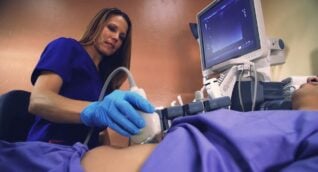Obstetrical ultrasound uses harmless sound waves to visualize the developing baby inside a pregnant woman’s uterus. The woman’s ovaries can also be examined during the same exam. The main advantage of using ultrasound is that no ionizing radiation (X-rays) is used, which makes ultrasound completely safe for mother and baby. Doppler ultrasound may also be performed to measure the blood flow to the umbilical cord, fetus, or placenta.
By using a special ultrasound transducer (probe), obstetrical ultrasound can visualize the body and organs of the developing baby, such as the baby’s size, heartbeat, and body movement. This helps doctors detect if there are any problems with fetal development or with the mother’s internal anatomy while it adapts to each phase of pregnancy.
More basic information on ultrasound is available in the About Ultrasound section.
Obstetrical ultrasound can be recommended in various situations associated with pregnancy, such as to:
- Confirm pregnancy and the presence of a living embryo or fetus
- Establish pregnancy stage
- Detect any congenital fetal abnormality
- Evaluate fetus, placenta, cervix, and amniotic fluid
- Follow fetal growth
- Assess fetal movement and heart function
Since ultrasound can produce real-time images, fetal movement and heartbeat can be seen on the monitor screen.
Benefits
- Obstetrical ultrasound is an inexpensive, fast, and non-invasive way to assess a woman’s pregnancy and the status of the developing baby.
- Ultrasound does not expose you or your baby to any ionizing radiation (X-rays).
- Unlike MRI, ultrasound can be used in patients with any type of metal in their body, including implantable medical devices.
- Ultrasound is very safe and has no side effects.
- There is no need to take contrast for ultrasound exams.
- Ultrasound can detect soft tissue abnormalities that cannot be visualized with regular X-ray exams.
Risks
- The use of diagnostic ultrasound (without biopsy) has no known risks or harmful effects. Ultrasound exams are safe at any stage of pregnancy.
- Any diagnostic test may lead to the recommendation of other tests, procedures, or surgery that may carry risks.
- Obstetrical ultrasound is done in an ARA imaging center. The exam will take about 30 minutes and you will be in the imaging center for about an hour.
- If you wear loose-fitting clothing, you will be asked to expose your lower abdomen for the exam. Otherwise, you may be asked to change into a gown.
- You will be placed lying on your back on an exam table. You may be asked to change position during the exam.
- A gel will be placed on your abdominal area. The gel creates a sealed contact between your skin and the ultrasound probe. This eliminates any air pockets that may interfere with imaging. The probe will be moved around to capture images from different locations.
- The technologist or doctor performing the study may have to apply firm pressure with the probe get the best view of the developing baby.
- A Doppler ultrasound may be performed with the same probe. You may hear pulsation sounds during this part of the exam.
- You can return to your normal activities after the exam is over.
Wear comfortable, loose-fitting clothing for the exam. If your clothes can be pulled down to expose your lower abdomen, you may not have to change into a gown.
To schedule an obstetrical ultrasound, please use our online scheduling tool in the Patient Portal or you may call our scheduling team at (512) 453-6100 or toll free at (800) 998-8214. A referral from your healthcare provider is required to make an appointment.
A radiologist, a physician specifically trained to interpret radiological examinations, will analyze the images and send a signed report to the provider who referred you to ARA. The physician will then share the results with you.
ARA wants to provide a safe, comfortable environment for patients and staff.
Patients may either bring or request a chaperone to accompany them during their exam to help protect and enhance their safety and comfort.
When requested, ARA will attempt to provide a chaperone with whom the patient feels comfortable. If a patient’s chaperone request cannot be accommodated, the patient will be given the opportunity to reschedule their exam.

 Back to Top
Back to Top